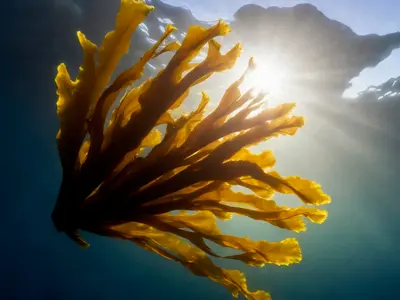
© W. Thomas - SBR
Despite their impact on a planetary scale, we still know relatively little about the composition of many of these microbial communities and even less about how they interact, function at the ecosystem level and adapt to ecological niches in a rapidly changing world. One of the main strengths of the ECOMAP team is to gather members with expertises on all size classes of plankton, including viruses, heterotrophic and photosynthetic prokaryotes, protists and other microeukaryotes, and covering a large spectrum of trophic modes (e.g., symbiosis, parasitism, kleptoplastidy, mutualism, etc.). Furthermore, these organisms are studied at all levels of organization from molecules (DNA, proteins, metabolites), cells, communities, to ecosystems and global ocean. Such a unique holistic approach, combining laboratory work on cultures of ecologically relevant model organisms and in situ studies, allows the ECOMAP team members to tackle many aspects of the structure, dynamics and ecological functions of planktonic communities, thereby linking the diversity, ecology, physiology and evolution of planktonic microorganisms.
We structured our project into three unifying research axes, which integrate our complementary scientific interests, skills and expertises.
Thematic Axes
Structure and dynamics of planktonic communities
Determine how the diversity, abundance, and dynamics of marine plankton communities are shaped by physical, chemical, and biological factors over different spatial and temporal scales, using a combination of flow cytometry, imaging, culture, molecular and meta-omics approaches. We rely on large datasets either retrieved from public databases or generated by members of the team from specific cruises/samplings of opportunity (TONGA, APERO, REFUGEARCTIC, MOOSE, BIOcean5D, etc.), time series (SOMLIT-ASTAN, BOUSSOLE, HOT, BATS, BLANES, etc.) as well as global expeditions (Tara Oceans, TREC, EMO-BON, BioGeoSCAPES, etc.)
Biotic interactions in marine ecosystem
Determine the nature, diversity and relevance of symbiotic associations for the productivity, resilience, connectivity, and recycling capacity of marine communities, notably in the context of global change, using various approaches: i) direct observations linking state-of-the-art automated high-resolution cell imaging to single-cell omics, ii) isolation of parasites and their host for use in mono- and co-culture experiments in the laboratory, and iii) genomics, transcriptomics, proteomics and/or metabolomics to assess biological changes related to the interactions between partners. We notably explore how the extended phenotype of holobionts plays a role in processes such as cell-to-cell communication, resistance to pathogens and grazers, facilitation for mutualistic symbioses, kleptoplastidy, adaptation to novel habitats, sexual reproduction as well as nutrient cycling and carbon export.
Adaptation and acclimation to the marine environment
Another goals of the ECOMAP team is to study the capacity of free-living or symbiotic planktonic organisms to acclimate (physiological plasticity) and adapt (acquisition/loss or alteration of genes) to variations of biotic and abiotic (temperature, light, availability in N, P, Fe, etc.) factors, notably in the context of global change. To do so, we use a cross-scale systems biology approach, including comparative physiology, genetics (CRISPR), (meta)omics and network approaches to describe and model i) the phenotypic plasticity of representative species or ecotypes (e.g. growth rate, trophic status or activity of key proteins in different conditions), and ii) the molecular and metabolic processes underlying adaptation to the various ecological niches. Members of the ECOMAP team are working on a variety of organisms covering a large range of sizes, including several model organisms, among which a particular focus is given on marine picocyanobacteria that can be studied at all levels of organisation from the genes to the global ocean.
Contact(s)
- Anne-Claire Baudoux
- Aurélie Chambouvet
- Laurence Garczarek
Projects
Ressources
People


Publications
Prokaryotic microbiota outperform eukaryotic microbiota in differentiating between infection states of iconic diseases of two commercial oyster species
K. Mathias Wegner, Benjamin Morga, Laure Guillou, Martina Strittmatter, Cyrielle Lecadet, et al.. Prokaryotic microbiota outperform eukaryotic microbiota in differentiating between infection states of iconic diseases of two commercial oyster species. Aquaculture, 2025, 594, pp.741363. ⟨10.1016/j.aquaculture.2024.741363⟩. ⟨hal-04665295⟩
Chromatic acclimation shapes phytoplankton biogeography
Francesco Mattei, Anna Hickman, Julia Uitz, Louison Dufour, Vincenzo Vellucci, et al.. Chromatic acclimation shapes phytoplankton biogeography. Science Advances , 2025, 11 (8), ⟨10.1126/sciadv.adr9609⟩. ⟨hal-04962714⟩
Symbionts of predatory protists are widespread in the oceans and related to animal pathogens
Fabian Wittmers, Camille Poirier, Charles Bachy, Charlotte Eckmann, Olga Matantseva, et al.. Symbionts of predatory protists are widespread in the oceans and related to animal pathogens. Cell Host & Microbe, 2025, 33 (2), pp.182-199.e7. ⟨10.1016/j.chom.2025.01.009⟩. ⟨hal-04968405⟩
Unraveling the Impact of Marine Heatwaves on the Eukaryome of the Emblematic Mediterranean Red Coral Corallium rubrum
Camille Prioux, Christine Ferrier-Pagès, Javier del Campo, Laure Guillou, Tristan Estaque, et al.. Unraveling the Impact of Marine Heatwaves on the Eukaryome of the Emblematic Mediterranean Red Coral Corallium rubrum. ISME Communications, 2025, ⟨10.1093/ismeco/ycaf035⟩. ⟨hal-04968489⟩
How institutions can better support international early-career researchers
Marek Lubośny, Pavanee Annasawmy, Itziar Burgués Martínez, Timotej Turk Dermastia, Lucía Espasandín, et al.. How institutions can better support international early-career researchers. Nature Human Behaviour, 2025, ⟨10.1038/s41562-025-02125-5⟩. ⟨hal-04979235⟩
Metabolic interdependence and rewiring in radiolaria-microalgae photosymbioses
Vera Nikitashina, Benjamin Bartels, Joost Samir Mansour, Charlotte Lekieffre, Johan Decelle, et al.. Metabolic interdependence and rewiring in radiolaria-microalgae photosymbioses. The International Society of Microbiologial Ecology Journal, 2025, 19 (1), ⟨10.1093/ismejo/wraf047⟩. ⟨hal-05055513⟩


